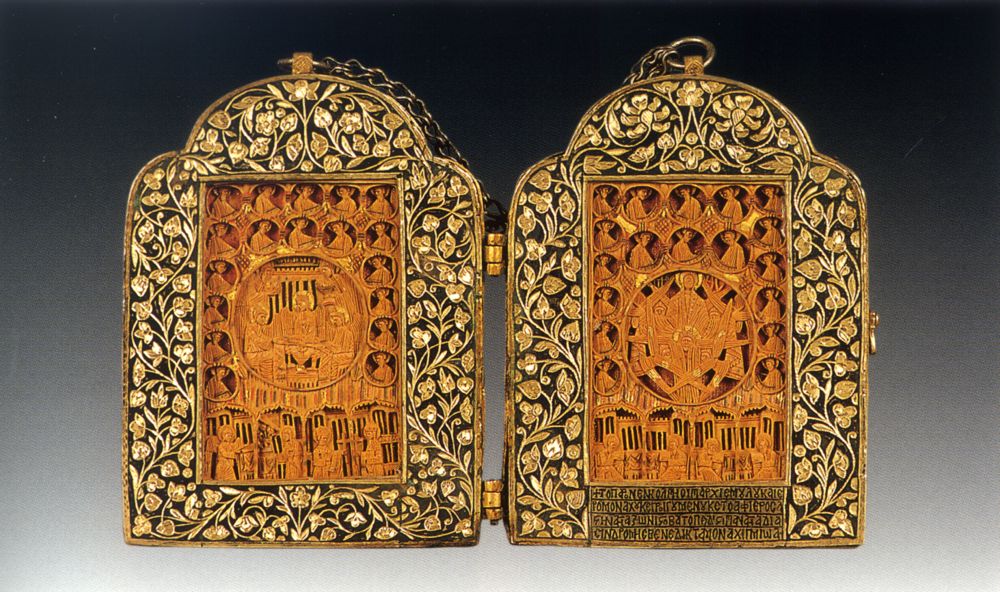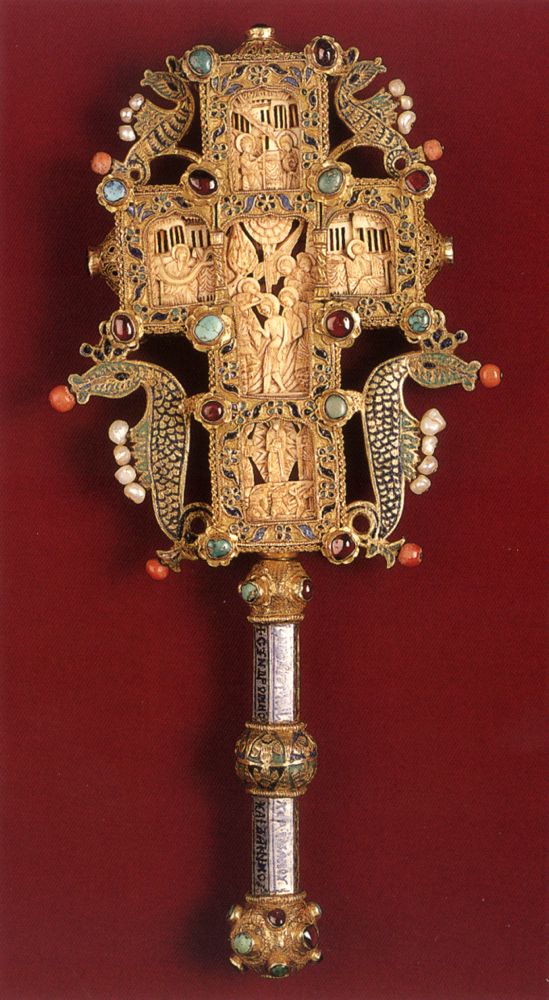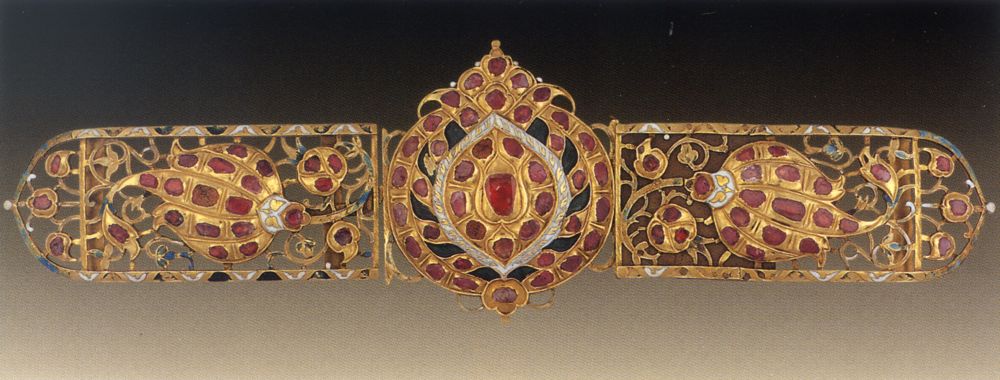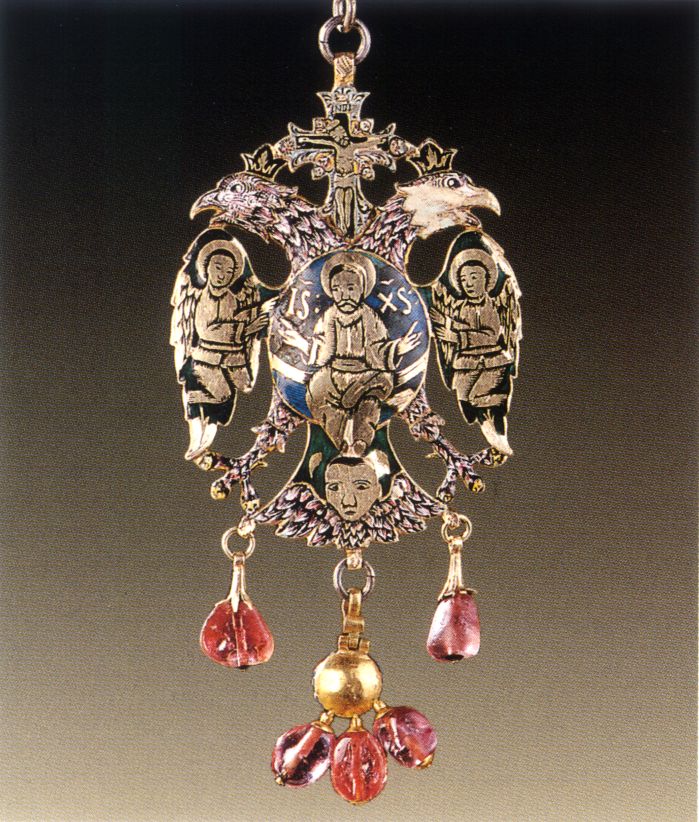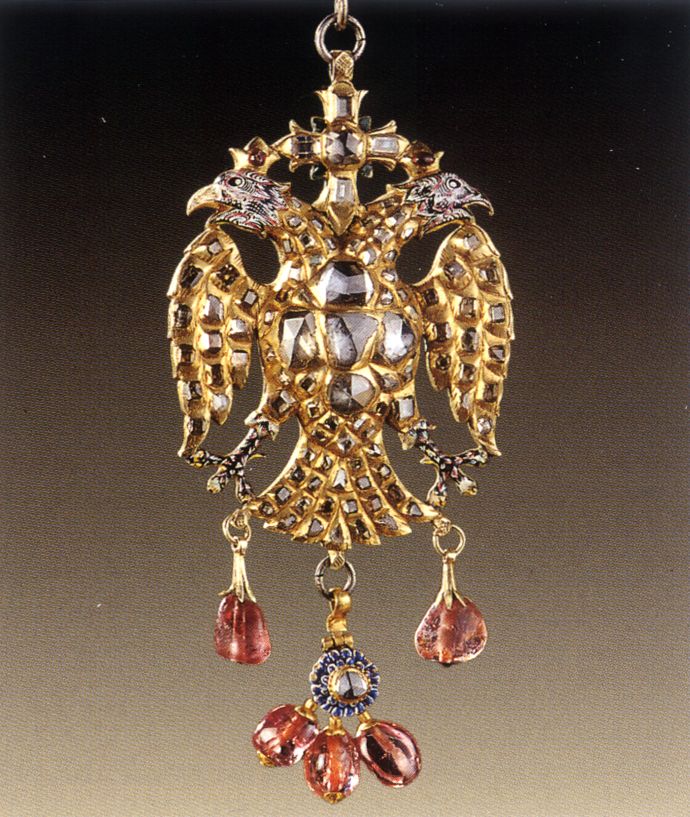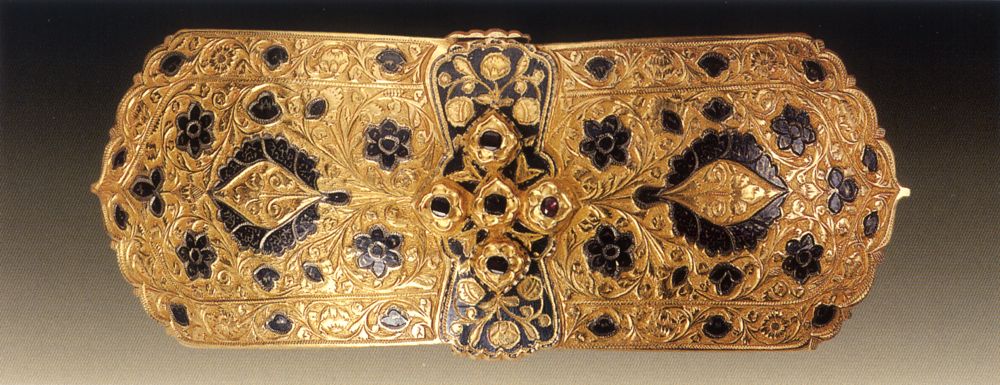The Art of Carving of Mount Athos, 17th-early 18th Centuries
7 November 2015The carving of wooden crosses is regarded as an art traditionally practiced by Athonite monks. Ioannis Komninos in 1698 and the Jesuit priest Braconnier in 1706 both refer to the carved wooden pectorals and crosses made by the monks in order to provide themselves with a livelihood. This tradition has been continued down to our own times; however, we know very little about its beginnings. Wood is a material which does not survive easily, and thus the majority of such crosses which have been preserved date from the later Ottoman centuries. The sacristy of the Monastery of Vatopaidi contains an interesting group of three crosses of the 17th century which provide material for an investigation of this tradition. The exceptionally elaborate carving of the religious scenes points to Cretan art and raises questions as to the influences which shaped small-scale church woodcarving. These influences are to be identified first of all in the Cretan iconographic models, but the possibility of the direct influence of Cretan woodcarving must also be examined. We now know of the production of carved wooden iconostases and their crosses and the trade in them in the Eastern Mediterranean and Italy, and this knowledge is supported by rich archival documentation. By way of contrast, the mounting of the crosses, and of other works of this period, is not linked with the parts of Greece under Venetian rule, but follows the style and techniques which spread from Constantinople to the regional centres of the Ottoman Empire.
The relatively large cross of 1639, “BY THE HAND OF PAPA EZEKIEL”, is perhaps unique for the quality of the woodcarving and the multi-figured scenes of the Dodekaorton* which flank the central scenes of the Crucifixion and Nativity. In the catalogue of sacred vessels which were delivered to the Monastery’s Sacristan in 1727, “dodekaorton crosses very large decorated with gold and silver, three” are mentioned.
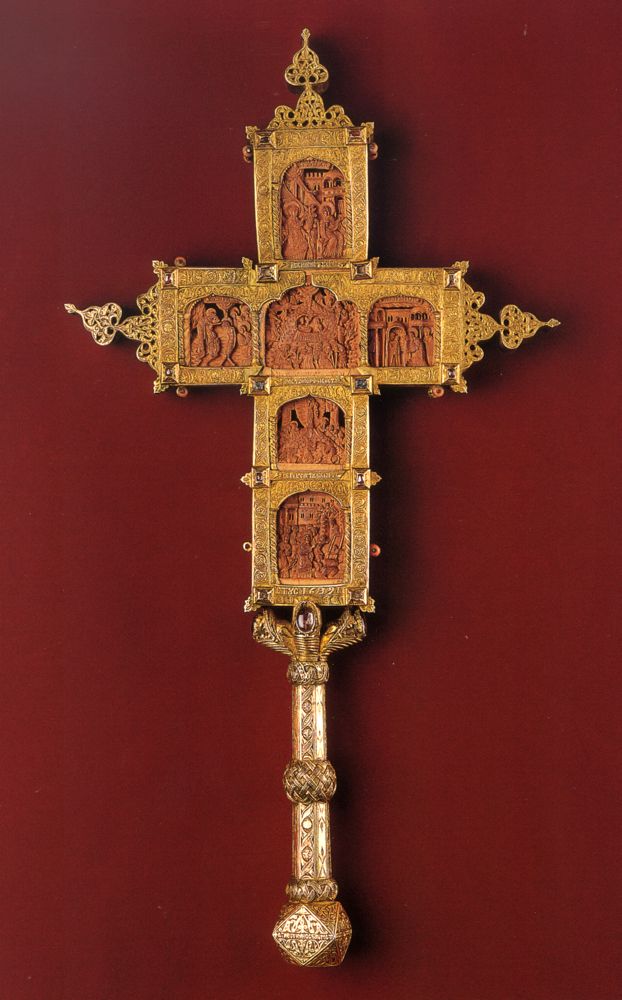
The term ‘Dodekaorton cross’ is indeed the appropriate one for this category of crosses and is used in other codices of the period. The Cretan iconographic models are reproduced on the cross with minute precision and against a background which is reminiscent of Renaissance scenery. An example of this is the figure of the woman watching from above the Entry of Jesus into Jerusalem, while in the Crucifixion, the garment of the woman behind the Blessed Virgin is fastened at the level of the knees, exactly like those of the virgins in the scene of the Presentation of the Virgin. At the foot of the Cross, two features are crowded in which exemplify the double background of the woodcarver’s training: the lamenting figure of Mary Magdalene from Italian painting and the depiction of Golgotha with the skull of Adam from the traditional iconography. The silver and gilt mount of the cross was made “BY THE HAND OF GEORGOS PIL[GRIM]”, whose skill was in no way inferior to that of the woodcarver. The faces are decorated with Ottoman saz leaves with rosettes, while a geometrical frame and half-palmettes combined with initial letters of an acrostic are carved on the sides of the mounting. The handle has four dragons supporting the base of the cross and holding a large red stone between their teeth.
The cross of 1669 has a similar iconography and layout of the scenes of the Dodekaorton, but the execution is less skilled.
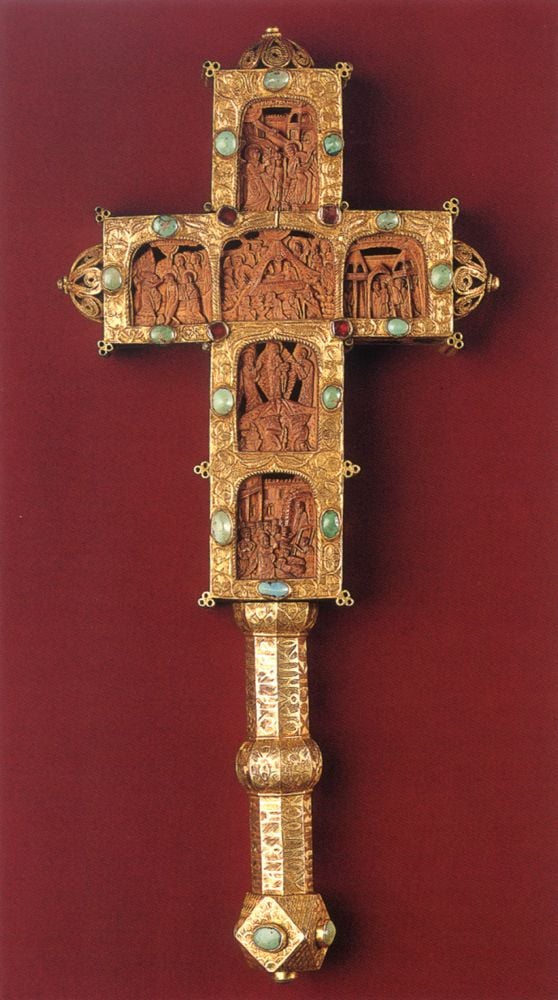
The chased gilt mount, with semi-precious stones in deep cylindrical settings scattered over its surface, is of greater interest. The winding scroll on the faces with the three-petalled palmettes, emphasised by hatching, reflects the new floral style of Constantinople, a kind of baroque arabesque which took shape under the influence of European decorative art. At the side, the palmettes are filled in with niello in fine spiral plant designs, which we also encounter on Ottoman objects of the same period. The well-written inscription on the handle reveals that the cross was made “AT THE EXPENSE OF THE MOST HONOURABLE LORD KYR NIKOLAI BOUHOSI AND GREAT LOGOTHETE AND OF HIS WIFE ANNA”. Nicolae Buhus, was Great Logothete at the court of Moldavia, while his wife, Anna, was of Greek descent.
In the catalogue of sacred vessels of 1727, we also have “crosses with arches on a throne, one large and six smaller”. This most probably refers to the type of cross of 1674, which rests on a hexagonal carved wooden base. At three successive levels, martyrs, hierarchs, and saints are shown under an arcade and do in fact support the carved wooden cross like a throne.
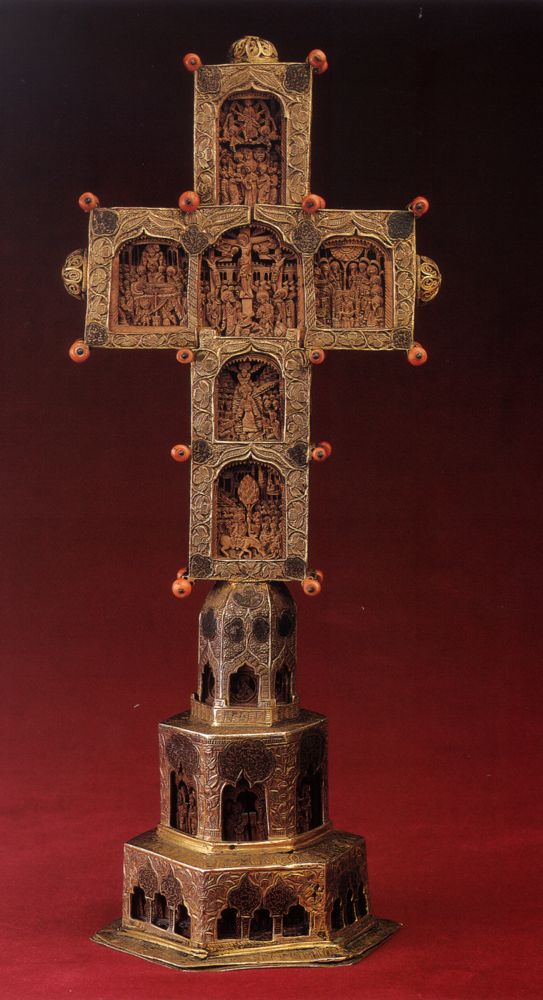
This type is known to us from the so-called Laskaris crosses, which date from the mid 16th century and have a similar but distinctly higher base33. The geographical distribution of the branches of the Laskaris family in Crete, Cyprus, the Ionian Islands, and Venice, and the stylistic approach link this group of crosses with the parts of Greece under Venetian rule34. Two of these, moreover, one in the Malcove collection with Latin inscriptions, and the other from Italy, now in Berlin, have been described as works of an ‘Italo-Cretan School’, but it is more likely that they are the work of Cretan woodcarvers.
The scenes from the Dodekaorton on the Vatopaidi cross “with arches” are almost identical with the cross of 1639. The minor differences lie in the architectural background or in the addition of details, such, for example, as the axe laid to the root of the tree behind John the Baptist in the Baptism scene. The mount has decoration similar to that of the Buhus, cross, and is probably the work of the same craftsman. The dedicatory inscription states that the cross was made at the expense of Abbot Christophoros in 1674, when he was Abbot of the Golia Monastery, Vatopaidi’s metochi* in Jassy. This was the Christophoros who paid for the restoration of the cemetery chapel at the Vatopaidi Monastery in 1683. Nevertheless, this type of decoration has no immediate connection with the Danubian Principalities, but is associated with early floral baroque, which, centring on Constantinople, spread to local workshops in the provinces.
This association is obvious in the case of a small enkolpion-panaghiarion* of 1670 with similar decoration signed by the master-craftsman Zotos and made with funds derived “FROM XANTHI FROM THE COUNTRY OF IOANNINA” .
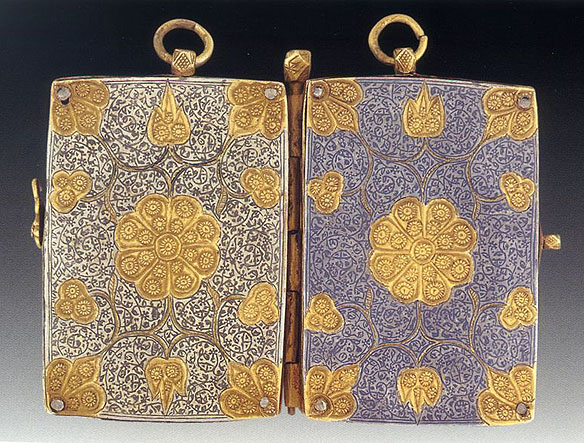
The shape of the enkolpion, with two leaves turning on hinges, is reminiscent of a small book, and perhaps the sharp colour contrast of the niello with the gilt rosettes is an attempt to imitate leather binding with its rich gold tooling. On one side of the carved wooden openwork leaves, which have traces of gilding and paint, is shown the Hospitality of Abraham, flanked by apostles and saints, while on the other, the Theotokos with Christ amid six-winged angels, attended by prophets, appears. This is the typical iconography used on panaghiaria, adapted to the oblong surface of the enkolpion, with the addition on the bottom narrow side of evangelists, saints, and the scene of the Annunciation.
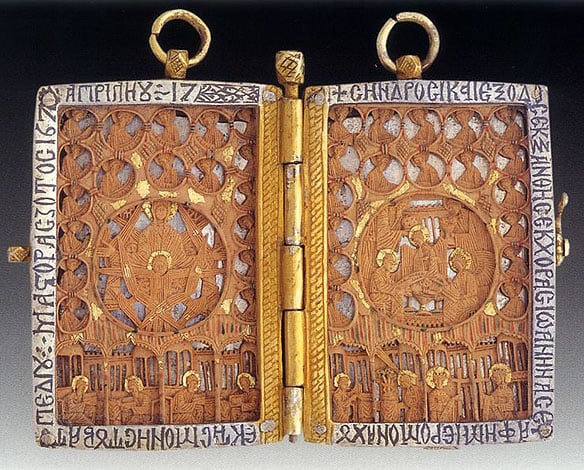
The enkolpion of Abbot Loukas, who in 1681 restored at his own expense a ‘house of prayer’, must also have been made around 1670.
The carved wooden leaves are completely identical with those of the preceding enkolpion, but the mounting is richer and combines the techniques of niello and of filigree enamel wire. Inside the panaghiarion, the broad border has as a background well-designed niello flowers, emphasised by hatching in symmetrical winding scrolls. The craftsman has attempted to introduce the same style of baroque Ottoman flowers into the border of the outside, but by the technique of filigree enamel. The Annunciation and Sts Helen and Constantine are depicted by the same technique in the central compartments of the two faces. The rendering of the elongated figures in fine twisted wire which forms cells filled with opaque enamel in shades chiefly of blue and green is stylistically very close to the casket (kivotion) of 1672, which was initially dedicated to the Stavronikita Monastery. This is one of the few known instances where filigree enamel is used in the portrayal of figures, rather than for non-figurative floral decoration. It was soon to be replaced by painted enamels, of Western origin.
The second half of the 17th century was the period at which the use of enamel by various techniques spread in silver-smithing. The two crosses of the Abbot Dionysios Xeniotis, of 1660 or 1669 and of 1678, are typical, if exceptionally rich, examples of the trends of the period, and must have corresponded to his social class, and to his economic standing. We know that he served as Abbot from 1669 to 1671, and that he restored the arsanas* of the Voivode Stephen the Great in 1672.
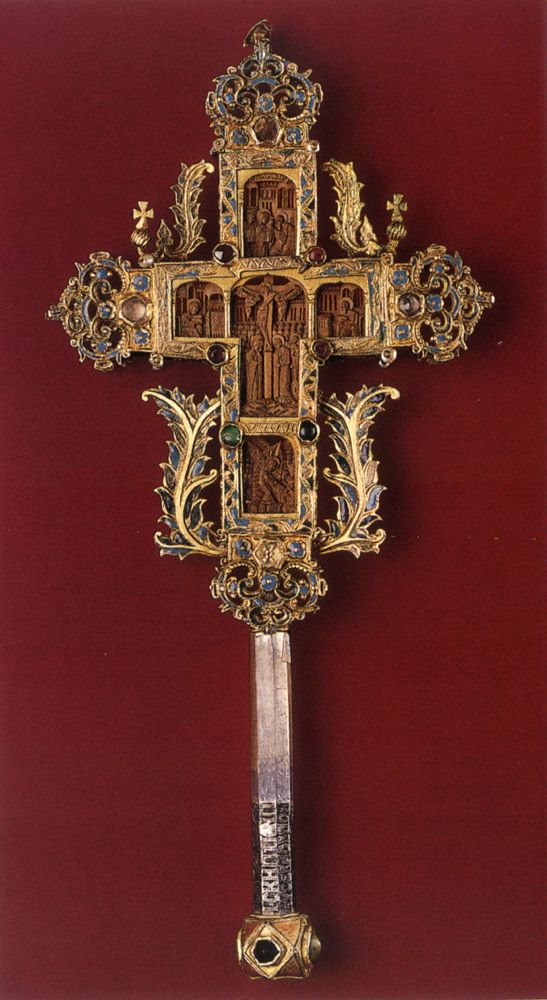
1660 or 1669
The cross of 1660 or 1669 has a large-size carved wooden core, the main scenes depicted on it being the Baptism and the Crucifixion. The inscription perhaps discloses something of the personality of its owner: “ALL-VENERABLE GOLD SCEPTRE DECORATED BY PRIEST-MONK DIONYSIOS OF VATOPAIDI”. The cross of 1678 has an ivory core with similar scenes and a valuable mounting signed “THE HAND OF IOANNIS”. The inscription “symeon” below the scene of the Crucifixion must be a record of the name of the ivory carver. Although the sources tell us that Athonite monks also carved ivory, no other examples of ivory crosses of this period are known. In the hierarchy of materials, wood can be used as a substitute for more precious ones such as – apart from ivory – jasper, steatite, and other hard stones. In the case of panaghiaria, the surviving examples from the last Byzantine and early post-Byzantine centuries allow us to trace this development and the transition from hard stones to the cheaper wood. However, the exceptions, such as the cross of Dionysios, confirm the continuation of the tradition and are evidence of the outstanding social position of the client. With both the crosses of Dionysios, the emphasis is on the mounting, with the bright multiplicity of colours of the enamel and the semi-precious stones. In the case of the cross of 1660 or 1669, the champlevé enamel, with light blue as the predominant colour, is opaque and viscous, the extremities of the arms are formed by openwork tendrils in a ‘C’ pattern, while large serrated leaves are nailed on the sides. The front, showing the Crucifixion, is also decorated with diamonds, cut in a novel way for the 17th century. The mounting of the ivory cross has the features which were to prevail in the 18th century: fine filigree enamel on the faces, flanked by pairs of dragons on the sides, though the dragons are not yet three-dimensional and of filigree, but flat and executed in champlevé enamel.
Without doubt, the most highly-renowned works of the 17th century are the jewellery which tradition has correctly called ‘Constantinopolitan’. It was to be expected that the sacristy of the Monastery of Vatopaidi would possess important examples of this genre. Its chief characteristics are gold, precious stones, and a progressively greater use of enamel. The luxuriously jewelled appearance of these items is typically Ottoman, but is also in keeping with the trends in a category of contemporary European jewellery which has a similar appearance, with precious stones in a floral or high-collar setting. The buckle in the Vatopaidi Monastery is an exceptional example, with finely-worked openwork tendrils and a use of enamel, exclusively champlevé, which is still limited in extent.
Of a little later date is the enkolpion in the shape of a double-headed eagle, similar to one in the Benaki Museum.
The European influences are stronger here, to be seen both in the extent of the painted enamel on part of the front and in the use of diamonds in place of the more usual rubies, as well as in the mixed nature of their cut, typical of Ottoman jewellery from the late 17th century onwards.
The buckle belongs within the tradition of Constantinopolitan jewellery, but is made of less luxurious materials and, consequently, was intended for a person of different social standing and income.
There are five semi-precious stones in the central part in the typical cast floral mounting. This central feature, which in the examples from the Ottoman court is made of nephrite, with inlaid gold jewelled stems, is supplied here by dark niello with gilt decoration in the familiar style of Ottoman baroque flowers. In the case of the side pieces of the buckle, a colour contrast is achieved by the reverse arrangement of a gilt background bearing decoration in niello.

